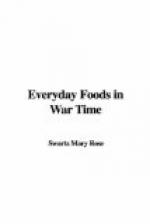Some people discriminate against canned and dried vegetables because they do not taste like fresh ones. This seems rather unreasonable, as we want a variety of flavors in our diet and might welcome the change which comes from this way of treating food as well as that which comes from different methods of cooking. Nobody expects a stew to taste like a roast, and yet both may be good and we would not want either one all the time. Instead of regretting that canned peas do not taste like those fresh from the garden (incomparable ones!) let us be glad that they taste as good as they do. Would we like them any better if they tasted like cornmeal mush?
While a potato has about as much phosphorus as an egg yolk, substitutes for it in this respect are not hard to find. Five tablespoonfuls of milk or half an ounce of cheese will easily supply as much, while half a cup of cooked string beans will provide all the iron as well as half the phosphorus in a potato, and a teaspoon of butter or other fat added to the beans will make them equal in fuel value. On the other hand, two small slices of whole wheat bread would furnish all the phosphorus, half the iron, and an equal amount of fuel.
The potato is conspicuously high in potassium, but it is not likely that in any diet containing one kind of fruit and one kind of vegetable each day there will be any permanent shortage of this substance. Spinach, celery, parsnips, lettuce, cabbage, rutabagas, beets, carrots, tomatoes, cucumbers, and turnips are all good sources of potassium and some of them are available all the year round without canning and drying.




